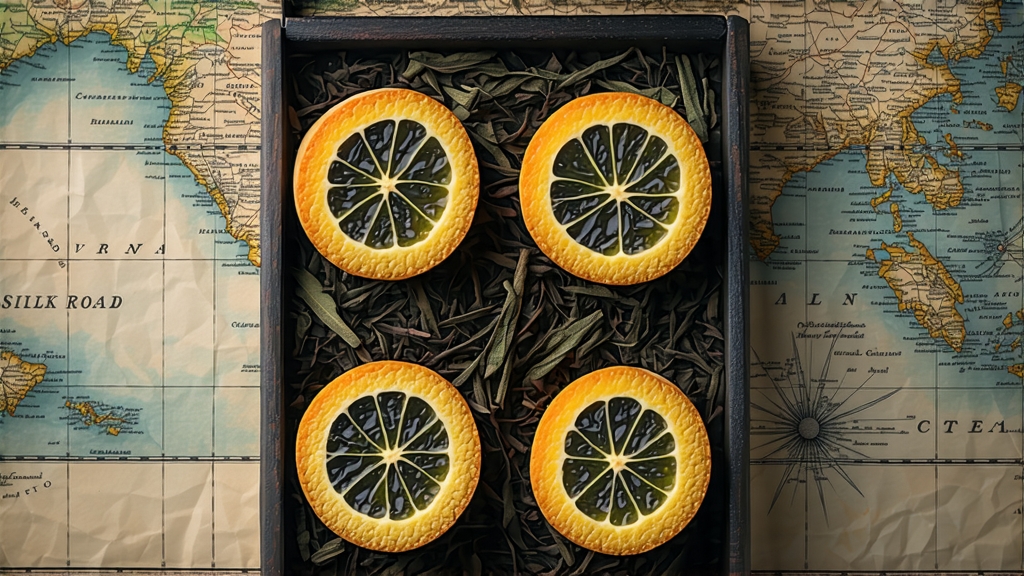
Few beverages carry the perfume of desert caravans and imperial granaries as vividly as Fu brick tea. Born in the lake-studded plains of Hunan and carried westward on camel humps to the markets of Kashgar, Lhasa and Alma-Ata, this dark, mellow tea is the living archive of China’s north-western trade routes. Today, when international drinkers speak of “black tea” they usually mean the fully oxidised red brew of Keemun or Assam, yet in Chinese taxonomy those are hong cha—“red tea”—while the true black teas, hei cha, are post-fermented, slow-aged and microbially sculpted. Among them, Fu brick (Fú zhuān chá) is the only variety whose quality is judged by the brilliance of the living flowers blooming inside its dense fibres.
Historical caravans and imperial patents
The story begins in 1368, the first year of the Ming dynasty, when the court created a Tea and Horse Bureau to barter Chinese leaf for Tibetan warhorses. Compressed bricks were ideal: they resisted humidity, occupied little space, and could be split into currency-like denominations. The small city of Jingyang in Shaanxi province became the first authorised workshop, but the raw material—large-leaf maocha—came from Hunan’s Anhua county, three weeks’ journey down the Xiang River. By the Qing era, annual caravans exceeding two million kilograms crossed the 3,000-metre passes of the Daxue range; Tibetan chronicles record that a single Fu brick could ransom a sheep, while five bricks bought a camel. In 1820, the imperial censor memorialised that “the brick is not merely drink, it is the quiet tether that binds frontier loyalty,” and the court granted Jingyang an exclusive patent seal still moulded onto modern products.
Microbial terroir: the golden flower
What distinguishes Fu brick from other compressed dark teas is the compulsory growth of Eurotium cristatum, a filamentous fungus that appears as tiny golden spots—jin hua, “golden flowers.” Far from being spoilage, these spores are the tea’s badge of authenticity. During the 7–10 day “flowering” phase, bricks are stacked in bamboo crates inside a 28 °C, 75 % r.h. cellar. The fungus consumes residual starch, releases extracellular enzymes, and lowers the tea’s catechins while raising soluble sugars and theabrownins. The result is a liquor that is naturally sweet, free of the musty earthiness that can plague other post-fermented teas. Modern metagenomic studies show that a well-flowered brick contains 1.2–2.5 × 10^6 CFU g⁻¹ of E. cristatum, plus minor populations of yeasts such as Cyberlindnera jadinii that contribute pineapple-like esters.
Crafting the brick: from fresh leaf to fungal bloom
The journey begins in early May, when the humid subtropical air of Anhua coaxes the local Yun-da-ye cultivar to a hand-span length. Pickers take one bud with four leaves, slightly tougher material than green tea standards because cellulose is needed for later microbial colonisation. The leaves are withered on bamboo racks for four hours, then pan-fired at 180 °C for eight minutes to arrest oxidation. What follows is unique: the half-dry leaf is piled 70 cm deep under wet cotton canvases for 4–6 hours, a mini “wet piling” that pre-conditions microbes. After rolling and a 24-hour low-temperature bake, the crude tea—maocha—arrives at the Jingyang factory where it will be sifted, steamed, and pressed.
Steam injection lasts exactly 18 seconds at 102 °C; too short and the brick will crumble, too long and spores die. A 2,000-gram steel mould is filled, pressed at 25 MPa for six minutes, and the newborn brick is slid into a pine-wood drying tunnel. Here the temperature rises in three stages: 35 °C for two days to evaporate surface moisture, 45 °C for one day to awaken spores, and finally 55 °C for twelve hours to fix the golden bloom. The entire cycle takes 30 days, after which the bricks rest for a minimum of six months before sale, although connoisseurs cellar them for decades.
Variations on a theme
Modern producers recognise